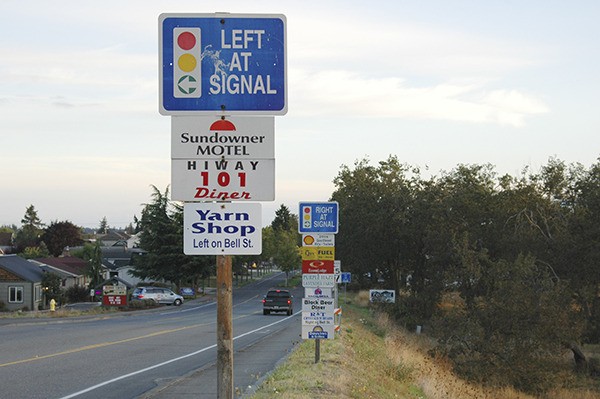Officials with the City of Sequim visited the Naval Air Station (NAS) on Whidbey Island late last month — a trip prompted by ongoing public concern associated with the Navy’s proposal to expand their electronic warfare training.
Charlie Bush, the city’s new city manager, noted the group visit while giving his report at Monday’s city council meeting.
“We learned a lot,” Bush said. “There are several flight paths near Sequim.”
The training aimed at improving aircrew training for aviators from electronic warfare squadrons based at NAS Whidbey Island would include three mobile emitter vehicles, Bush explained. Although the vehicles are expected to travel throughout 15 locations within western portions of the Olympic Peninsula via U.S. Forest Service roads, according to Navy officials, the proposal doesn’t introduce new flight paths, he said.
However, nearby residents continue to voice concerns regarding the existing training and the proposed plan, including noise pollution from the Navy’s EA 18G Growler aircraft, possible periodic closures of portions of Olympic
National Forest, electromagnetic radiation exposure and potential adverse economic impacts.
“We’re very concerned with the Growlers,” Sequim resident Doug Goldie told the city council Monday night.
Within a 25-day period, Goldie admitted to calling the Navy’s hot-line 33 times with no call back in response to seemingly low-flying aircraft near his home in Blyn.
The information provided by Goldie was contradictory to what city officials were told by Navy officials during their visit to the air station, Bush said, and thus told Goldie he would personally contact the Navy to inquire further.
“The Navy has been consistently dishonest about this,” councilor Ken Hays, said. “They’re not being honest about their flight patterns and I think we need to continue to press them on the matter.”
Approved items, new signage
Among the sustained concerns with the presence of Growlers overhead, the city council unanimously approved the renewal of a three-year contract between the city and the Sequim-Dungeness Valley Chamber of Commerce to allow mobile food service vendors the option to locate at Centennial Place up to 10 times until October 2018.
Additionally, councilors approved an ordinance aimed at amending the Sequim Municipal Code to allow city staff to move forward with upgrading the South Sequim Avenue area and specifically the motorist information signs.
“The South Sequim Avenue entrance is cluttered with follow-through signs,” Karen Kuznek-Reese, city clerk, said.
The Washington State Department of Transportation requires all businesses with signs along U.S. Highway 101 to have follow-through signs upon exiting the highway and if a turn is needed, Kuznek-Reese said.
In response, city staff plan to work with the participating businesses owners to bring their business’ signs into compliance with the state highway requirements. Already, new signage backdrops were ordered from the city’s General Fund for the follow-through signs on South Sequim Avenue and Washington Street, costing $3,176.
Fifteen businesses with signage on U.S. Highway 101 would require follow-through signs in the city.
“Once completed, this will provide a more attractive entrance into the city, increase awareness for the business and provide consistent signage which conforms to the state guidelines,” Kuznek-Reese said.
Based on the improvement costs incurred by the city, staff recommended a fee structure mirroring Clallam County’s, including a $200 installation fee and $35 annual permit fee. Any fees associated with the project are to be included in the fee ordinance scheduled for discussion by the city council on Sept. 28.
Ongoing matters
Chris Hugo, City of Sequim director of community development, provided the city council with an overview of the effort to update the Sequim Comprehensive Plan. After months of review, the city’s planning commission still is evaluating the 2015 draft plan, but Hugo anticipates a recommendation from the commission by the end of September.
“The goal is to have this voted on before the end of the year so everyone on the current city council can participate,” Hugo said.
In hopes of beginning the public hearing process, Hugo plans to present the final draft to the city council on Oct. 12.
Additionally, city officials continue to gather input on the formation of a broad-based Metropolitan Park District, but have gained little enthusiasm beyond their own.
“We’ve completed most of our initial outreach,” Bush said. “The response has been neutral to not right now.”
Lastly, city councilors discussed a staff-recommended ordinance to provide a deferred collection of development impact fees prior to the state requirement to do so.
The recommendation is in reaction to the law passed by the Legislature requiring cities to defer collection of impact fees, which as development persists, can aid in transportation, park and school projects.
The state law doesn’t take effect until Sept. 1, 2016, but city staff anticipate early implementation of a deferred collection of development impact fees to be beneficial.
“Early implementation encourages developers not to delay construction until after Sept. 1, 2016,” Craig Ritchie, city attorney, told city councilors. “Early implementation also allows us to start getting fees into the pipeline earlier.”
Because the collection delay may be up to 18 months, city officials need to prepare for the cost associated with monitoring the activity of each development and individual house to ensure the fee eventually is collected, Ritchie said. To help with costs, an administrative fee is likely to be implemented and it won’t “nominal,” he said.
The proposed ordinance is expected to resurface before the city council on Sept. 28.


